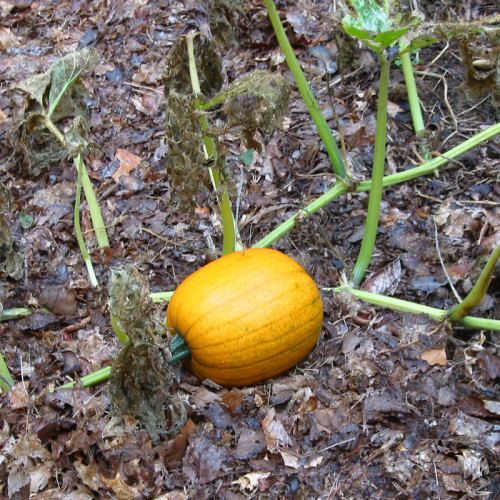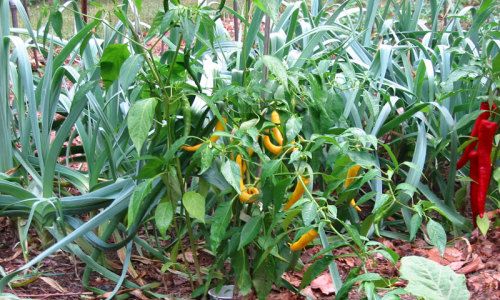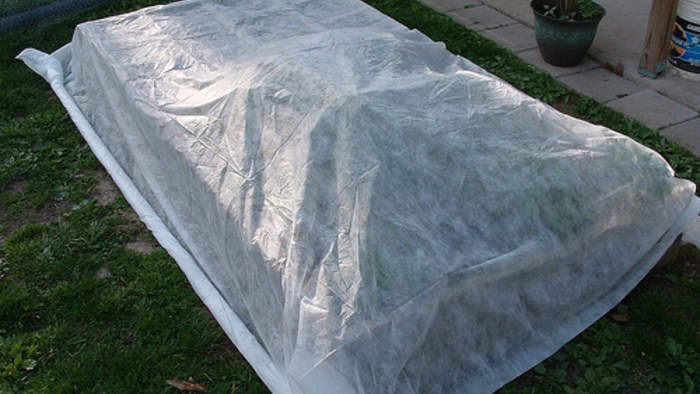
It’s September. Kids return to school, the sun is lower in the sky, the nights grow nippy. There’s a crispness to the air, and if you look carefully, you’ll catch the tinges of color in the New England swamplands. Ordinary folk watch football. Gardeners go on frost watch.
If you’re new to gardening, you may not be aware that frost can wipe out most of your veggies. So here are some things you should know about frost and how to protect your garden against it, or at least forestall its effects.
| What is frost, and what does it mean for your garden? Ice crystals form at temperatures below 32°F, when water vapor condenses out of the air and settles on a cool surface, such as your garden beds or garden plants. Frost is just a frozen form of dew, and it damages plants by freezing the water inside the plant cells, which then burst and die.A light frost can occur at 30° to 32°F. There’s a touch of white on the ground, but it’s short-lived; as soon as the sun hits it, it’s gone, and all but the most frost-sensitive plants will survive. At lower temperatures, a killing frost can occur, and you can pretty much say good-bye to most of your annual flowers and most vegetables. |
The Farmer’s Almanac can tell you the average killing frost date for your area (here in Connecticut, it’s October 10), and that will give you a general ideal of what to expect. But it won’t help you much with anticipating light frosts. You also have to know your microclimate. A low-lying area may be covered in frost, while just uphill a bit everything is fine.
As we all know, weather can be quirky. As the days get shorter, I check the forecasts frequently, and I get a sense of things as I walk the dog after work. Is the sky cloudless and the wind minimal? Is there a chill in the air? Does it smell like frost? If so, there’s work to be done.
When frost threatens
Crops differ in their susceptibility to frost, and there are steps you can take to extend the season. These maneuvers are worthwhile, because typically a frost is followed by Indian summer and its warm, sunny weather before things really chill down.
If a light frost is predicted, I cover my frost-sensitive crops with assorted bedsheets, blankets, and tarps and hope for the best. The next morning, anticipating rising temperatures, I remove the coverings.
If you don’t cover your plants and frost hits them, you can sometimes save them by hosing off the frost early in the morning before the sun hits them.
What to harvest when
If you’re like me, you’ll want to keep your garden going as long as you can. So you won’t want to put your garden to bed until it becomes absolutely necessary.
The measures described above work for a while, but at a certain point, enough is enough. Even if the plants are alive, they are no longer actively producing. When a hard frost is imminent, I bow to the inevitable. After thanking the garden (my quiet, but essential annual ritual), I harvest all remaining tomatoes (ripe or not), cucumbers, hot peppers, sweet peppers, eggplant, beans, and basil, along with any frost-sensitive flowers I’d like to enjoy a bit longer in a vase—or in a salad.
I don’t usually harvest the winter squash and pumpkins yet, as these survive just fine in the field even if the vines die. Leeks, scallions, beets, and carrots are in no danger from frost either, and members of the cabbage family—brussels sprouts, broccoli, and kale—actually improve in flavor with frost. These remain flavorful even into winter most years. Parsley also does well until Thanksgiving and sometimes beyond, as do sage and chives.
| A quick guide to frost hardiness | ||
| Frost sensitive (Harvest these plants when the temperature dips to 32°F or less) |
Somewhat frost hardy (These crops may survive temperatures as low as 28°F) |
Very frost hardy (Don’t rush to harvest these; they’ll be fine at 28°F or colder) |
| Tomatoes Cucumbers Hot peppers Sweet peppers Eggplant Beans Basil Nasturtiums Melons Summer squash Sunflower |
Lettuce Arugula Chard Escarole Endive Cabbage Nicotiana |
Leeks Scallions Chives Brussels sprouts Broccoli Kale Parsley Beets Carrots Winter squash Pumpkins Sage |
Fine Gardening Recommended Products

The New Organic Grower, 3rd Edition: A Master's Manual of Tools and Techniques for the Home and Market Gardener, 30th Anniversary Edition
Fine Gardening receives a commission for items purchased through links on this site, including Amazon Associates and other affiliate advertising programs.

Gilmour 5/8" x 25' Round Weeper Soaker Hose
Fine Gardening receives a commission for items purchased through links on this site, including Amazon Associates and other affiliate advertising programs.

The Regenerative Landscaper: Design and Build Landscapes That Repair the Environment
Fine Gardening receives a commission for items purchased through links on this site, including Amazon Associates and other affiliate advertising programs.





















Comments
Log in or create an account to post a comment.
Sign up Log in